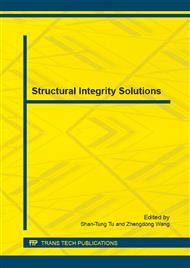[1]
Rahul Unnikrishnan, K.S.N. Satish Idury, T.P. Ismail et al. Effect of heat input on the microstructure, residual stresses and corrosion resistance of 304L austenitic stainless steel weldments. Materials Characterization, 2014 (93): 10-23.
DOI: 10.1016/j.matchar.2014.03.013
Google Scholar
[2]
Chin-Hyung Lee, Kyong-Ho Chang, Ki-Tae Park et al. Bending resistance of girth-welded stainless steel circular hollow sections. Thin-Walled Structures. 2013 (73): 174-184.
DOI: 10.1016/j.tws.2013.08.002
Google Scholar
[3]
C.S. Pande, M.A. Imam. Nucleation and growth kinetics in high strength low carbon ferrous alloys. Materials Science and Engineering A. 2007 (475): 69-76.
DOI: 10.1016/j.msea.2006.12.043
Google Scholar
[4]
B. Nageswara Rao, A.R. Acharya. Fracture behavior of a high strength medium carbon low alloy steel. Engineering Fracture Mechanics. 1996 (53): 303-308.
DOI: 10.1016/0013-7944(95)00091-7
Google Scholar
[5]
C.G. Zhang, P.M. Lu, X.Z. Hu. Residual stress and softening in welded high strength low alloy steel with a buffering layer. Journal of Materials Processing Technology. 2014 (214): 229-237.
DOI: 10.1016/j.jmatprotec.2013.09.002
Google Scholar
[6]
B. Berdokhti, A.H. Koukabi, A. Dolati. Influences of titanium and manganese on high strength low alloy SAW weld metal properties. Materials Characterization, 2009 (60): 225-233.
DOI: 10.1016/j.matchar.2008.09.005
Google Scholar
[7]
Y.W. Shi, Z.X. Han. Effect of weld thermal cycle on microstructure and fracture toughness of simulated heat-affected zone for a 800MPa grade high strength low alloy steel. Journal of Materials Processing Technology. 2008 (207): 30-39.
DOI: 10.1016/j.jmatprotec.2007.12.049
Google Scholar
[8]
S.W. Ooi, J.E. Garmham, T.I. Ramjaun. Review: Low transformation temperature weld filler for tensile residual reduction. Materials & Design. 2014 (56): 773-781.
DOI: 10.1016/j.matdes.2013.11.050
Google Scholar


